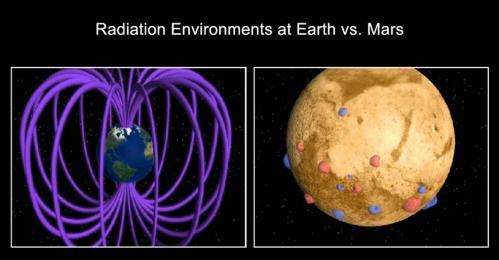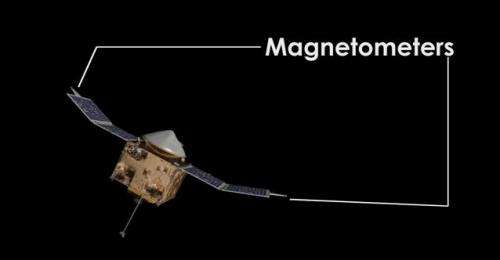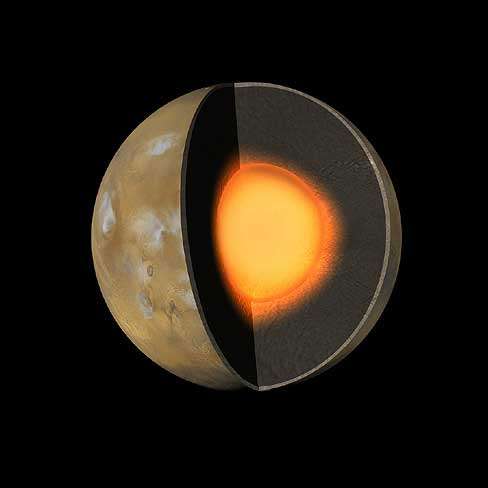How magnetic crustal fields affect planets

If you are ever lost on the surface of Mars, don't count on a compass to help you get home. On Mars, compasses don't work.
They don't work because there is not one magnetic field on Mars, rather there are dozens. These small fields are powerful, concentrated in the crust, and scattered over the surface of the planet. In their absence, compass needles would lie still; in their presence, they spin, pointing first at one bar magnet, then another. How well these crustal fields protect the planet is a mystery, and one that may be solved soon by the MAVEN satellite, which is on its way to Mars right now.
What we do know is that if a compass ever worked well on Mars, it was over 3.5 billion years ago. Before that time, Mars had a molten core, whose contents constantly churned upward towards the surface. This process of convection permitted cooling of the interior, as well as active volcanism in the highlands and plains. Volcanoes brought iron to the surface, giving Mars its signature color. Iron in the core also moved electrons, which created a planetary dynamo: a device that converts mechanical energy into electric energy. Electric fields generate magnetic fields. Large magnetic fields can provide protection from solar wind for any planet as long its interior maintains a steadfast supply of molten metal.
Large magnetic fields also decay unless maintained. After the first billion years or so, the Martian interior cooled to the point where convection halted. When the iron ceased to flow, the dynamo died. Volcanism declined. The last iron deposits from the interior left their marks as pockets of magnetism, called crustal anomalies, largely sequestered in the southern hemisphere.
"Mars is on the interesting borderline of the magnetized and the unmagnetized objects," said Janet Luhmann, MAVEN's deputy principal investigator. "We think that the weak magnetic field has been in place since it was about a billion years old."
We first learned about Mars' strange magnetic fields from the way they interacted with the solar wind. In 1965 Mariner 4, one of America's first interplanetary probes, passed within 8,000 kilometers (4,971 miles) of Mars' surface. At that distance, it failed to detect any magnetic field. By contrast, Earth's planet-wide field can be sensed by magnetometers within 60,000 kilometers (37,282 miles). What Mariner did note was that the solar wind was being bent around the planet, widely in some places.
In 2001, near 40 years after remaining fields were inferred by the deflection of the solar wind, NASA's Mars Global Surveyor confirmed the presence of remnant magnetic fields, concentrated exclusively in ancient crust. These were deposited, we believe, before the death of the dynamo.
The MAVEN satellite will make the first detailed observations of atmospheric loss in regions with and without these crustal anomalies. It will also observe the power of the incoming solar wind in those regions. The end result will be not only better maps of magnetic fields, but also detailed knowledge how much protection those lingering fields may be providing to the remaining atmosphere.
"In some scenarios the mini-magnetospheres will protect the atmosphere more from solar wind erosion," said Jared Espley, science lead for MAVEN's two high-resolution magnetometers. "In other scenarios, the mini-magnetospheres will reconnect with the solar wind magnetic fields and pinch off whole chunks of the ionosphere at once and let it get carried away by the solar wind. The MAVEN science team is keen to specifically investigate these types of trade-offs."

Two high-resolution magnetometers (MAGs) have been charged with the task of mapping what remains of the magnetosphere. Putting sensitive magnetic detectors on a powerful satellite was an engineering challenge. MAVEN is endowed with nine sensors, each receiving current from solar panels as long as a school bus, creating a local magnetic field.
Espley said that to protect the twin magnetometers from the satellite's own field, "it was arranged to have every wire on the solar array have a wire on the backside running in the opposite direction. Then these currents more or less cancel each other out and we get very little magnetic contamination."
The MAGs were also placed as far away from the other sensors as possible: on the far ends of the solar panels, where they peak out like golden wingtips.
Like MAG, the Langmuir Probe and Waves (LPW) instruments required shielding from MAVEN's electric and magnetic fields. While in deep space, they are tucked into the satellite's main bus, with only the tips of their tines exposed. Robert Ergun, the science lead for LPW, described the visual effect of the two 1-meter LPWs as, "sort of like an old-fashioned television." After MAVEN's arrival they will lengthen to 7 meters (23 feet long), like very long radio antennae.
Langmuir probes were invented in 1924 by the man who pioneered the concept of electron temperature: Irving Langmuir. They measure not only electron temperature, but also electron density, was well as the energy of plasma: free-flowing protons and ions that account for the majority of the ionosphere. Ninety years after Langmuir's invention, MAVEN's LPW probes will be acting as meters in the Martian ionosphere, measuring electron density and temperature as a function of altitude.
Higher temperature electrons contribute to loss of charged oxygen ions from the atmosphere. They drag ions to higher altitudes. There, they can be pickup up and dragged away by the solar wind. High electron temperatures contribute to atmospheric escape here on Earth everyday, and probably exert an even more powerful force on Mars. In spite of being substantially further from the Sun, electron temperatures in the Martian ionosphere can be shockingly high: on the order of 1,000 Kelvin (1,340° Fahrenheit or 727° Celsius). By contrast, the temperature of Earth's ionosphere tops out around 300 Kelvin. Where an Earth-bound oxygen ion might re-combine, become neutral and linger in the atmosphere, that same ion contending with more energetic Martian electrons might fail to capture one, remain charged, and be stripped away by the electric solar wind.
While MAVEN uncovers electron temperatures with Langmuir Probe and Waves, it will task STATIC, the last instrument in the ion-related properties and processes group, to measure ions like oxygen before they recombine or escape. Like LPW, STATIC (Super-Thermal and Thermal Ion composition) will extend away from from the satellite's central hub after orbital insertion. Unlike LPW, morphologically, STATIC looks a bit like a small black-and-gold merry-go-round.
"The unique design permits STATIC to measure ions coming from nearly all directions, with changes in sensitivity that vary by a factor of a thousand, and over an energy range that changes by a factor of 100,000," said science lead Jim McFadden. "STATIC measures the distribution of positively charged particles (ions) – their velocity (or energy & direction), and mass."

As ions whizz around, STATIC will measure how many are approaching escape velocity. It will do this at many altitudes, to quantify which parts of the atmosphere are being lost, and at what rate. As solar activity varies, STATIC will mark how many more ions pick up the necessary speed to leave. It will also help determine the difference between Mars' own layer of plasma and the solar wind, as the two intertwine and produce super-thermal ions that stream away from the ionosphere.
Super-heated ions may also be contributing to the disappearance of Mars' atmosphere. As Mariner 4 recorded, what little magnetism remains in Mars' crust bends some of the solar wind, sweeping it around the planet. Where the magnetosphere meets the solar wind, particle motion resembles water parting around the bow of ship. That part of the magnetosphere is called the bow shock.
Outside the bow shock, matter from the sun in pushed aside. Inside the bow shock, drag from the solar wind grabs bits of plasma rotating in the same direction as the planet, causing them to pick up speed. As these ions become super-heated, they are blown back from day-side toward the night-side of Mars. The ensuing plasma tails swath the planet in a halo, with the appearance of long hair blowing away from the sun, disappearing into space. The particles in those of the tails are pieces of the oxygen, carbon dioxide and water molecules that used to be Mars' atmosphere.
Plasma tails, electron temperatures and magnetic fields all impact the atmosphere around Mars. STATIC, MAG and LPW will measure how each responds to different types of energy, to changes in the solar wind, and to the arrival of solar storms.
In terms of solar storms, MAVEN will arrive on the downslope of a solar cycle, during the optimum window for observing one of the most powerful forces affecting atmospheric escape: coronal mass ejections.
"More CMEs (and larger CMEs) occur during the declining phase of the solar cycle, rather than at maximum," said Frank Eparvier, science lead on the Extreme Ultraviolet Sensors attached to LPW. "MAVEN will be at Mars during the declining phase of the current solar cycle, so we will actually be there at the right time to see CME impacts."
Though Mars has no dynamo, no compass navigation, and only a wisp of an atmosphere, it does have MAVEN heading there at high speed, aiming to come closer to the surface than any orbiter in history. The measurements MAVEN makes will be critical to the planning and execution of human and robotic missions. MAVEN's accounts of CMEs interacting with crustal fields may steer us towards a future landing site that would afford more protection for a human mission. After studying the magnetic-fields with MAVEN, and mapping the surface with future missions, we might devise a functional navigation system similar to Earth's GPS. We have every hope of finding the answers we need to make it there and back, using MAVEN's clearer view of the Martian sky to guide to our journey.
Provided by Astrobio.net





















